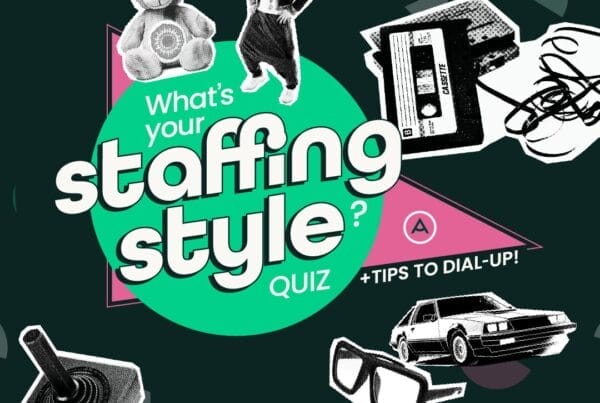Time-to-hire is an important metric for any healthcare business. Your average time-to-hire refers to the average length of time it takes you to bring a new team member onboard, starting from the moment you first made contact with that specific candidate.
Your time-to-hire is distinct from your time-to-fill, which covers the entire period you had a vacancy, before you even started sourcing candidates. But by improving your hiring process, you’ll be able to hire the best candidates more quickly and spend less time with unfilled positions.
1. Healthcare has one of the worst time-to-fill rates of any industry
Historical data shows that healthcare takes longer to fill vacancies than almost any other industry. In 2017, it took healthcare employers an average of 49 days to fill a role. That was higher than any other surveyed industry.
Most recently, a LinkedIn study has found that the industry with the longest time-to-fill is engineering, also at 49 days. This isn’t surprising—in general, it takes longer to fill positions that require more specialized education and experience. Healthcare is still up there as one of the slowest industries in hiring, with the average time-to-hire driven up by more senior clinical positions.
2. Filling hospital roles can take up to 250 days
Again, specialized roles take longer than average to fill. Knowing this, it makes sense that certain clinical roles take longer to fill than any other roles in healthcare. The more education and experience required for a position, the more time and energy recruiters can expect to spend looking for the right person.
In some cases, it can take up to 250 days, or over eight months, to fill a role. Healthcare hiring involves a lot of red tape. Many businesses are dealing with a long application review process, extensive applications, and issues with credentialing.
Filling a vacancy should never take so long it’s damaging your ability to provide great care. Better candidate sourcing, streamlined recruitment, and the right technology can all help cut this time down.
3. Healthcare’s fill rate is one of the lowest of any industry
It’s not just time-to-fill that’s a problem for healthcare. Sometimes open positions aren’t filled at all. In worst case scenarios, healthcare businesses might not be able to maintain their staffing ratios, affecting patient care and business funding.
Health services ties with education for the industry with the lowest fill rates in recent years. The Bureau of Labor Statistics calculates this ratio by comparing the number of hires in a month to the number of job openings from the end of the previous month. Historic data shows that healthcare’s fill rates have been as low as 0.5 in recent years, meaning only half of all open healthcare positions were filled. Healthcare is an incredibly competitive industry to be hiring in. With not enough talent to fill all roles, some positions are left unoccupied.
4. Healthcare employment trends can be misleading
Overall, healthcare employment did improve over the course of 2021. But this doesn’t necessarily mean everyone was thriving. Ambulatory care had the best year for recruitment of any healthcare sub-field. Meanwhile, hospitals and skilled nursing facilities actually had an overall reduction in employment in 2021.
When reviewing statistics on time-to-hire in healthcare, it’s important to remember that healthcare is a big industry with a lot of variety in staffing trends. The best way to monitor your business’s outlook is to track your own metrics. What is your average time-to-hire? Knowing this will allow you to track success much more effectively than comparing yourself to other irrelevant industries.
5. Texting candidates can radically improve your average time-to-hire
Americans are texting a lot. Pew Research Center has found that smartphone ownership is continuing to steadily increase, especially among young and college-educated people. Today, 97% of Americans own a cellphone and 85% own a smartphone. For Millennials and Gen Z, smartphone usage is almost universal—about 95.5% of Americans under 50 own a smartphone.
In theory, the widespread use of smartphones means that healthcare candidates are more accessible than ever before. But to meaningfully take advantage of this situation, healthcare recruiters need to implement text recruiting. Texting candidates results in quicker response times, and, therefore, a reduced time-to-hire.
6. 57% of candidates get fed up with waiting around after an interview
According to a study conducted by Robert Half, 57% of American job-seekers say long waits after an interview are the most frustrating part of the application process. These candidates ranked the long post-interview wait as more frustrating than scheduling delays prior to the interview, multiple interview requests, and even showing up for an interview and discovering the job was different than advertised. Another 39% of respondents say a lengthy hiring period makes them lose interest in the company.
When candidates get tired of waiting around, they’re likely to pursue other opportunities. If you have a long period of time between conducting interviews and making an offer, chances are you’re losing top candidates to competitors. Ideally, you want your whole hiring process to operate quickly and efficiently. But if you’re going to focus on trimming days from one portion of hiring, start by giving your candidates an answer more quickly.
7. The average time-to-hire varies by region
Just like average time-to-hire varies by role and profession, it also varies by region. Southern states have both the highest hire rate (5% of total employment) and the highest quit rate (3.5% of total employment) of any region in the United States. Workers in these states are more likely to leave their positions, find new ones, and onboard rapidly.
There are multiple reasons this might be the case. Just like more specialized roles take longer to fill, employees in niche and high-paid positions are less likely to quit their jobs. The regional density of certain roles may affect why certain areas of the United States see a shorter time-to-hire.
8. Only 23% of recruiters focus on this important metric
In 2021, American recruiters reported that their top two priorities were improving the quality of the hires (52%) and their retention rate (24%). By comparison, only 23% of recruiters said that they were focusing on reducing their average time-to-hire.
It’s no secret that hiring in healthcare is intense. We know that the industry is experiencing a talent shortage. Qualified applicants are limited, and businesses are trying to recruit the same top candidates. For this reason, reducing time-to-hire is actually vital to your healthcare staffing success. Speeding up hiring is the only way to ensure that you onboard your top applicants before they find work at another business.
9. Average time-to-hire was increasing well before the pandemic
If average time-to-hire is so important, businesses must be working really hard to decrease it, right? Well, maybe so. But the unfortunate truth is that time-to-hire has been rising across industries for years, well before the COVID-19 pandemic made hiring even harder.
Between 2010 and 2015, the average time to fill a job rose by 62%. What does this tell us? Pandemic recovery efforts alone won’t fix a process that was already broken. To reduce your average time-to-hire, focus on improving your candidate sourcing and the efficiency of your internal process.
10. 50% of healthcare recruiters blame candidate sourcing for a lengthy time-to-hire
A lengthy time-to-hire isn’t fun for anyone. While job-seekers say their main complaint is the post-interview wait, recruiters have another concern: inadequate candidate sourcing.
About half of all healthcare recruiters say their time-to-fill is long because they have trouble finding enough candidates. This tracks with what we know about the healthcare talent shortage. Currently, healthcare average time-to-fill is almost double the average time-to-hire. To put it another way, half of the time it takes to fill a healthcare vacancy is just dedicated to looking for candidates. Clearly, building a better applicant sourcing system is the first step to fixing healthcare staffing.
11. The larger the business, the slower the interview process
Time-to-hire is also affected by the size of the business. In the United States, the average business with 10 – 49 employees takes about 15 days to complete the interview process. Businesses with 1,000 – 99,999 employees, meanwhile, take about 25 days.
Of course, this period is even longer in healthcare, where the time-to-hire is generally more extended. But it’s worth noting that large businesses can drag down your hiring time. This trend suggests that bureaucracy, distance, and trouble communicating internally can all create hiring challenges. Candidate sourcing is important, but so is the efficiency of your internal operations.
12. Interviewing alone takes over three weeks on average
There are plenty of moments when your hiring might hit bumps in the road. One of the most common times for this to happen is during interviews.
Across industries, it takes American recruiters an average of 24 days to complete the interview process. This could happen because of conflicting schedules, missed dates, multiple interview rounds, or lengthy periods between interviews. To combat this, recruiters need a clear hiring workflow including rapidly scheduled interview sessions. More lines of communication with candidates can also help.
13. The right software can reduce average time-to-hire by 71%
A long time-to-hire average can be a tough hurdle to overcome. But the right healthcare hiring software can cut it down dramatically while also reducing manual labor and bringing clarity to your internal communications.
Data gathered by Apploi has shown that our customers can reduce their days-to-hire by 21% in the first 90 days of use, and by 71% after a longer period of time. Our suite of tools is designed to help you hire quickly and easily, with automated workflows, interview reminders, and centralized internal candidate management. As an end-to-end healthcare staffing solution, Apploi trims days from every stage—from candidate coursing and screening to hiring and onboarding.
Better Healthcare Staffing With Apploi
No matter your current average time-to-hire, you can decrease it with the right software. Apploi is here to simplify your healthcare staffing. We help employers source candidates, streamline hiring, and onboard new recruits. Hire painlessly to make a great impression on new applicants.
Interested in learning more about how you can recruit, hire, and onboard healthcare staff quickly? Contact us today for a free demo of our end-to-end talent management solution.





